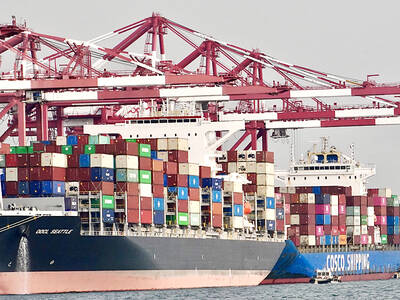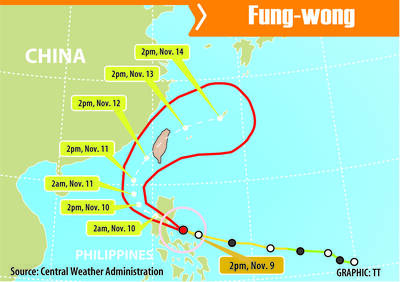A top US expert on Asian military affairs said that espionage allegations against General Lo Hsien-che (羅賢哲) of Taiwan were “deadly serious” and potentially “very damaging.”
Richard Fisher, a senior fellow at the Washington-based International Assessment and Strategy Center, said it was of “utmost importance” that Taiwan and the US “be far better informed of the range of current and future developing threats from China.”
Other sources directly involved with US intelligence — speaking on the strict condition of anonymity — said there was “concern” in Washington over the allegations, but that the case was too sensitive to comment further at this stage.
Fisher said Lo’s arrest was only the latest espionage exposure in a mostly silent “war” extending back for almost four generations.
“General Lo’s case is deadly serious because he was in charge of what was to be Taiwan’s most important force multiplier in the event of war — the ‘Po Sheng’ or ‘Broad Victory’ digital multi-service command, control and intelligence system,” Fisher said.
“Po Sheng was intended to allow Taiwan’s armed forces to transition into the modern age of true joint warfare where different services can cooperate intimately for faster mission success,” he said.
“It is not difficult to see how the PLA [People’s Liberation Army] would view the ability to turn off or take control of Po Sheng as critical to a range of coercive military scenarios that could lead to political capitulation in Taipei before the start of full attack,” Fisher said.
“What if a future Chinese agent in the presidential palace was able to show a future Taiwan president that the PLA, through its control of Po Sheng, was ordering Taiwan’s armed forces into a massacre? The war might end before it even starts,” he said.
Fisher said Lo’s reported disclosure of Taiwanese communication networks and potentially of details regarding US and Taiwan military communications was also “very damaging” and could be much worse if Taipei and Washington “fail to draw the right lessons.”
For both the US and Taiwan, it is of utmost importance to be far better informed of the range of current and future developing threats from China, he said.
The Chinese “dictatorship wants to extinguish democracy in Taiwan far more than it wants to use Taiwan as a military base, though it wants that too,” he said.
“For Americans, a Communist Chinese takeover of Taiwan would unleash a new Cold War from a foe much more deadly and determined than the Soviet Communist Party. But if Washington can ensure the survival of a free Taiwan, the fact of its existence will undermine the legitimacy of the [Chinese] Communist Party regime and create more pressure for its reform,” Fisher said.
“While there may be some in Washington who will hold up General Lo as evidence that Taiwan is too dangerous to defend, too much of a threat to the security of American technology, that would also be a victory for China,” he said.
“The real lesson is that defending freedom is not easy, and never free. We need to be far better in the spy wars and demand the same from Taipei, but we must also increase our support for Taiwan to prove we value their freedom,” Fisher said.

The Central Weather Administration (CWA) yesterday said it expected to issue a sea warning for Typhoon Fung-Wong tomorrow, which it said would possibly make landfall near central Taiwan. As of 2am yesterday, Fung-Wong was about 1,760km southeast of Oluanpi (鵝鑾鼻), Taiwan’s southernmost point, moving west-northwest at 26kph. It is forecast to reach Luzon in the northern Philippines by tomorrow, the CWA said. After entering the South China Sea, Typhoon Fung-Wong is likely to turn northward toward Taiwan, CWA forecaster Chang Chun-yao (張峻堯) said, adding that it would likely make landfall near central Taiwan. The CWA expects to issue a land

Taiwan’s exports soared to an all-time high of US$61.8 billion last month, surging 49.7 percent from a year earlier, as the global frenzy for artificial intelligence (AI) applications and new consumer electronics powered shipments of high-tech goods, the Ministry of Finance said yesterday. It was the first time exports had exceeded the US$60 billion mark, fueled by the global boom in AI development that has significantly boosted Taiwanese companies across the international supply chain, Department of Statistics Director-General Beatrice Tsai (蔡美娜) told a media briefing. “There is a consensus among major AI players that the upcycle is still in its early stage,”

The Central Weather Administration (CWA) yesterday said it is expected to issue a sea warning for Typhoon Fung-wong this afternoon and a land warning tomorrow. As of 1pm, the storm was about 1,070km southeast of Oluanpi (鵝鑾鼻), Taiwan’s southernmost point, and was moving west-northwest at 28 to 32kph, according to CWA data. The storm had a radius of 250km, with maximum sustained winds of 173kph and gusts reaching 209kph, the CWA added. The storm is forecast to pass near Luzon in the Philippines before entering the South China Sea and potentially turning northward toward Taiwan, the CWA said. CWA forecaster Chang Chun-yao (張峻堯) said

Japanese Prime Minister Sanae Takaichi yesterday said that China using armed force against Taiwan could constitute a "survival-threatening situation" for Japan, allowing the country to mobilize the Japanese armed forces under its security laws. Takaichi made the remarks during a parliamentary session while responding to a question about whether a "Taiwan contingency" involving a Chinese naval blockade would qualify as a "survival-threatening situation" for Japan, according to a report by Japan’s Asahi Shimbun. "If warships are used and other armed actions are involved, I believe this could constitute a survival-threatening situation," Takaichi was quoted as saying in the report. Under Japan’s security legislation,